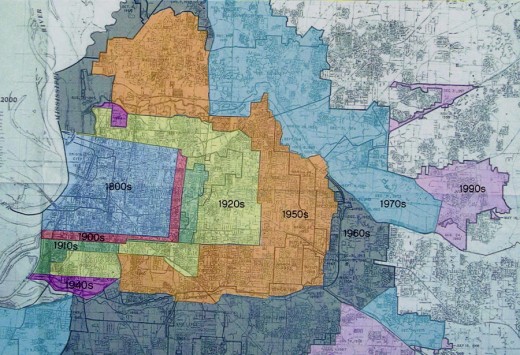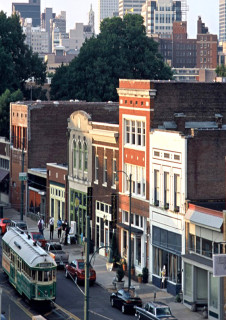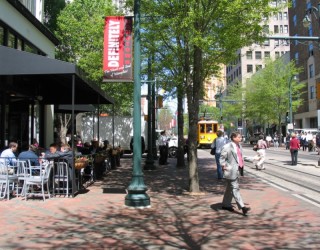Downtowns in many American communities have experienced more than fifty years of neglect, abuse, and abandonment. There are a number of factors that have contributed to this indifference toward our central cities. Several decades of bad public policy, private market forces, as well as individual prejudices have all worked counter to the health of central cities.
Fortunately over the last two decades this trend has slowly begun to shift. Today, cities of all sizes have implemented plans to revitalize, re-grow, and reinvent their downtowns.
Why are downtowns important and why the need for all of these revitalization strategies? Because downtowns are the heart of a city and region — and having a healthy heart is essential to having a strong city and region.
Noted urban economist Edward Glaeser recently described cities as mankind’s greatest invention. Glaeser noted that while urban cores have a reputation of being “dirty, poor, unhealthy, crime-ridden, expensive and environmentally unfriendly,” they are actually the “healthiest, greenest, and richest (in cultural and economic terms) places to live.” 1 He makes a very forceful case for the city’s importance and provides economic proof that central cities are our best hope for the future.
In my hometown of Memphis, Tennessee, like many cities in United States, downtown’s decline began in the 1960s and continued for several decades. As in many other places, government policies and incentives fueled outward growth that left urban centers a shell of what they once were. This outward growth, now commonly referred to as “sprawl,” led to the erosion of city centers and massive income-based segregation. Other side effects from outward migration left the less mobile urban population with fewer job opportunities and access to basic services, as well as leaving children and the elderly lacking independence.
The City of Memphis’ annexation map reflects the outward migration and geographic expansion of the City. The geographic size of Memphis expanded from 50.9 square miles in the 1940’s to 340.5 square miles today. During that same time period, however, population density dropped from 7,800 to 1,900 people per square mile.

Although I use Memphis as one example, this pattern of low-density sprawl development continues to be prevalent throughout America and in many cities around the world.
It does not take a Rhodes Scholar to realize that this is an unsustainable model. The ripple effect of this development pattern has shaped our culture and our lifestyles of a generation, damaging our financial and physical well-being. We are coming to the realization that government budgets cannot fund adequate levels of service for the sprawling municipal infrastructure.
We are also seeing the results of an auto-centric and sedentary lifestyle on public health. A New York Times article notes that “researchers predict that today’s children will be the first generation of Americans whose life expectancy will actually be shorter than that of their parents.” 2 Moreover, individuals and families are investing a disproportionate amount of time and fiscal resources on transportation to get to separated single-use destinations on which they depend.
All of these “symptoms” — not to mention the impact of our land development and transportation patterns on climate change — make a compelling argument for change.
The Pendulum Swings Back!
A gradual and surprising shift toward downtown reinvestment began to occur in many U.S. cities during the 1980’s. This movement of urban reinvestment was led by urban pioneers, who were seeking a traditional urban lifestyle and had an opportunity to invest at rock bottom prices. What made this shift so surprising was that it began simultaneously with federal government austerity policy that “trickled” the burden of government down to states and eventually to municipalities.

Many of the neighborhood revitalization efforts have been supported by the National Trust for Historic Preservation’s Main Streets Program which assists communities with their neighborhood redevelopment efforts. What began as isolated investments, combined with hard work over the past 20 to 30 years, have paved the way for today’s large scale revitalization of center city neighborhoods.
In Memphis, the slow rebuilding of our downtown began with the creation of a public-private redevelopment agency, focused on downtown and the reopening of the historic Peabody Hotel. A series of major investments brought downtown Memphis back, and in 2007 the Urban Land Institute’s Urban Land Magazine named it a top U.S. turn-around city.
The downtown revitalization efforts in Memphis have received awards from the International Downtown Association and the Urban Land Institute.
Why Rebuild Downtown First?
Downtowns are iconic and powerful symbols for a city and often contain the most iconic landmarks, distinctive features, and unique neighborhoods. Given that most downtowns were one of the oldest neighborhoods citywide, they offer rare insights into their city’s past, present and future.
Revitalization of downtowns and central city neighborhoods can be challenging at best. They can be gritty, cranky, often struggling, and contentious — but are always exciting. They are also often the hotbeds of business creativity, neighborhood activism, non-profit entrepreneurs, economic diversity, and an attraction for visitors, seniors, and young talent.

A city’s downtown area has an important and unique role in economic and social development. Downtowns create a critical mass of activities where commercial, cultural, and civic activities are concentrated. This concentration facilitates business, learning, and cultural exchange.
Although much work has yet to be done, today many downtown and main street neighborhoods are some of the most productive neighborhoods.
But what is meant by the term productivity of a neighborhood, and how is it measured?
Until recently there has been a lack of good downtown-specific information in most cities, which is sometimes why it is hard to make the economic case for investment in downtown.
The Canadian Urban Institute (CUI) was engaged by the International Downtown Association’s Canadian Issues Task Force to carry out one of the most significant reviews of downtowns to date.

The report, “The Value of Investing in Canadian Downtowns,” collected data from Canada’s major cities, to establish benchmarks for downtown vibrancy and productivity.
The report cited that many municipalities have begun to re-evaluate what is happening in their downtowns. There is a growing understanding that a strong downtown can be a major stimulator for economic growth and potentially a key revenue generator for local government.
The CUI study documented the major contribution downtowns are making to the economic health of their respective cities, now and into the future. The downtowns featured in CUI’s report often take up as little as one percent of citywide land area, but attract ten or twenty times that in terms of contributing to the City’s assessment base and generating property tax revenues. All of the downtowns featured in this report are making major contributions to their city’s bottom line and economic prosperity.
Along similar lines, the Downtown Memphis Commission’s “2013 Downtown Metrics Report” found that a square mile of downtown property generates more than twice the county and city taxes as an average square mile in the city as a whole and more than three times the county tax revenue when compared to the same amount of land in Shelby County. 3
Downtowns throughout North America are making a major contribution to the bottom line of their municipalities. In most cases downtowns serve as the engine for local economies. However, downtowns are much more than a profit center to cities. They also represent the image and character of a city to the rest of the world. Downtowns are unique in that they are typically the only neighborhood that belongs to and is shared by everyone in the region.
In today’s global economy with competition between municipalities for jobs and talent it is critical that cities have a shared vision centered on a redevelopment plan for their downtown.
In the coming months I will be reporting on issues focused on downtowns and main streets. The subjects of upcoming articles will include: critical steps in revitalizing downtowns; community engagement in the development process; and is it tactical urbanism or public vandalism? If there are downtown-related topics you’d like to see addressed, please e-mail me c/o PlannersWeb at pcjoffice@gmail.com.
Andy Kitsinger is a principal consultant at The Development Studio, a firm focused on helping clients build stronger communities. He writes about Downtown and Main Street Issues.
Kitsinger’s thirty-year career as an architect, urban designer, city planner, and teacher has focused on creating authentic places that are strongly influenced by their context and have a positive impact on their community. He teaches Issues in City Building and Architectural Design Studio at the University of Memphis’ Department of Architecture.
Kitsinger served as the Senior Vice President of Planning & Development for the Downtown Memphis Commission (formally Center City Commission) for the last eight plus years where he helped continue the momentum of downtown while working to improve the livability and the quality of life in the City.
We look forward to upcoming columns by Kitsinger on a range of downtown and main street issues.